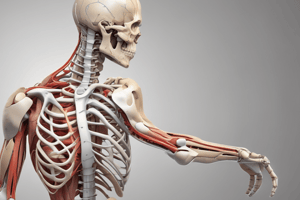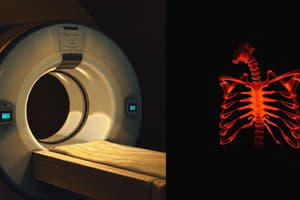Podcast
Questions and Answers
Which condition is most likely associated with altered shoulder alignment due to overuse in athletes?
Which condition is most likely associated with altered shoulder alignment due to overuse in athletes?
- Secondary Impingement (correct)
- Thoracic Outlet Syndrome
- Chondrosarcomas
- Frozen Shoulder
What posture might indicate a potential case of Thoracic Outlet Syndrome?
What posture might indicate a potential case of Thoracic Outlet Syndrome?
- Forward head posture with rounded shoulders (correct)
- Scapulae fully retracted
- Dominant side higher than non-dominant side
- Pelvic position aligned with spine
What is a characteristic posture in individuals suffering from a Frozen Shoulder?
What is a characteristic posture in individuals suffering from a Frozen Shoulder?
- Normal spinal alignment
- Excessive shoulder elevation
- Scapular protraction and depression (correct)
- Scapulae symmetrically aligned
Occupational shoulder injuries are most common in which of the following activities?
Occupational shoulder injuries are most common in which of the following activities?
Which of the following is NOT a typical finding in someone with a postural dysfunction affecting the shoulder?
Which of the following is NOT a typical finding in someone with a postural dysfunction affecting the shoulder?
At what age is frozen shoulder most commonly seen, assuming no trauma is involved?
At what age is frozen shoulder most commonly seen, assuming no trauma is involved?
What is a significant cause of secondary impingement in the shoulder?
What is a significant cause of secondary impingement in the shoulder?
Which demographic is most likely to present with chondrosarcomas?
Which demographic is most likely to present with chondrosarcomas?
What symptom might suggest thoracic outlet syndrome in shoulder assessment?
What symptom might suggest thoracic outlet syndrome in shoulder assessment?
Which group is most likely to experience secondary impingement?
Which group is most likely to experience secondary impingement?
Which of the following statements is true regarding the dominant shoulder?
Which of the following statements is true regarding the dominant shoulder?
What common shoulder complaint indicates potential vascular involvement?
What common shoulder complaint indicates potential vascular involvement?
Which condition is likely to develop from rotator cuff degeneration?
Which condition is likely to develop from rotator cuff degeneration?
What is a common symptom of a pectoralis major rupture?
What is a common symptom of a pectoralis major rupture?
Which condition is characterized by snapping or clunking sounds when moving the shoulder?
Which condition is characterized by snapping or clunking sounds when moving the shoulder?
Which assessment position is used to evaluate scapula symmetry?
Which assessment position is used to evaluate scapula symmetry?
What type of gait observation should be noted during an assessment?
What type of gait observation should be noted during an assessment?
Which of the following is a sign of supraspinatus tendinitis?
Which of the following is a sign of supraspinatus tendinitis?
What is a characteristic feature of static winging of the scapula?
What is a characteristic feature of static winging of the scapula?
Which of the following conditions can result from chronic subluxations?
Which of the following conditions can result from chronic subluxations?
Which condition is indicated by a sulcus sign during shoulder assessment?
Which condition is indicated by a sulcus sign during shoulder assessment?
Which symptom would most likely be absent in a frozen shoulder diagnosis?
Which symptom would most likely be absent in a frozen shoulder diagnosis?
What is a typical observation that indicates thoracic outlet syndrome?
What is a typical observation that indicates thoracic outlet syndrome?
Flashcards
Rotator Cuff Degeneration Age Range
Rotator Cuff Degeneration Age Range
Rotator cuff degeneration is commonly seen between the ages of 40 and 60.
Primary Impingement Age
Primary Impingement Age
Individuals over 35 years old are more prone to primary impingement, a condition related to degeneration and weakness of the shoulder.
Calcium Deposits Age Range
Calcium Deposits Age Range
Shoulder calcium deposits may develop between the ages of 20 and 40.
Chondrosarcoma Age
Chondrosarcoma Age
Signup and view all the flashcards
Frozen Shoulder Age Range
Frozen Shoulder Age Range
Signup and view all the flashcards
Secondary Impingement Age
Secondary Impingement Age
Signup and view all the flashcards
Dominant Shoulder Characteristics
Dominant Shoulder Characteristics
Signup and view all the flashcards
FOOSH (Fall On Out Stretched Hand)
FOOSH (Fall On Out Stretched Hand)
Signup and view all the flashcards
Diabetes mellitus
Diabetes mellitus
Signup and view all the flashcards
Rotator cuff repair
Rotator cuff repair
Signup and view all the flashcards
Total shoulder arthroplasty
Total shoulder arthroplasty
Signup and view all the flashcards
Forward head posture
Forward head posture
Signup and view all the flashcards
Scapular protraction
Scapular protraction
Signup and view all the flashcards
Medial Border Palpation
Medial Border Palpation
Signup and view all the flashcards
Scapula Symmetry
Scapula Symmetry
Signup and view all the flashcards
Gait Assessment
Gait Assessment
Signup and view all the flashcards
Tropical Changes
Tropical Changes
Signup and view all the flashcards
Pectoralis Major Rupture Signs
Pectoralis Major Rupture Signs
Signup and view all the flashcards
Lateral Compartment Pain
Lateral Compartment Pain
Signup and view all the flashcards
Sulcus Sign
Sulcus Sign
Signup and view all the flashcards
Posterior Compartment Pain
Posterior Compartment Pain
Signup and view all the flashcards
Thinker's Position
Thinker's Position
Signup and view all the flashcards
Anterior Compartment Pain
Anterior Compartment Pain
Signup and view all the flashcards
Study Notes
Shoulder Joint Assessment
-
Glenohumeral Joint:
- Resting position: 40°-55° abduction, 30° horizontal adduction (scapular plane)
- Close packed position: Full abduction, lateral rotation
- Capsular pattern: Lateral rotation, abduction, medial rotation
-
Acromioclavicular Joint:
- Resting position: Arm resting by side in normal physiological position
- Close packed position: 90° abduction
- Capsular pattern: Pain at extremes of range of motion, especially horizontal adduction and full elevation
-
Sternoclavicular Joint:
- Resting position: Arm resting by side in normal physiological position
- Close packed position: Full elevation and protraction
- Capsular pattern: Pain at extremes of range of motion, especially horizontal adduction and full elevation
Demographic Data
-
Age:
- Many shoulder problems are age-related.
- Rotator cuff degeneration: 40-60 years
- Primary impingement (due to degeneration and weakness): >35 years
- Calcium deposits: 20-40 years
- Chondrosarcomas: >30 years
- Frozen shoulder: 45-60 years (if not from trauma)
-
Occupation:
- Secondary impingement (instability due to weakness in scapular or humeral control muscles): common in late teens/20s
- More common in overhead activities (swimmers, baseball pitchers)
-
Hand Dominance:
- Dominant shoulder often lower
- Dominant shoulder usually shows greater muscularity but often less range of motion (ROM)
Chief Complaint
- Pain
- Restricted motion
- Instability
- Feeling of weakness/heaviness in limb after activity
- Limb tires easily (possible vascular involvement)
- Swelling/stiffness (possible venous symptoms)
Thoracic Outlet Syndrome
- Pressure on neurovascular structures at 3 locations: scalene triangle, costoclavicular space, under pectoralis minor/coracoid process
Present Illness
- Anatomical site (e.g., fall, blow to shoulder/elbow)
- Limb position (e.g., FOOSH injury, subluxation/dislocation)
- Subjective experience (snapping, cracking sounds, "popping out")
Pain History
- Location (where)
- Referred pain (if present)
- Duration (when)
- Type of pain (what)
- Aggravating/relieving factors
Past Medical History
- Includes medical, surgical, personal, and occupational history (diabetes, arthritis, surgery, sleeping positions, occupation/repetitive movements)
Assessment
- Ocular Inspection (posture, pelvic and spinal alignment, shoulder/protective guarding)
- Standing Posture (anterior, lateral, posterior view - e.g., dominant side slightly lower, scoliosis, scapula position)
- Gait (posture, limb movement, any external devices)
- Tropical Changes (color, texture, scar, bruises)
Palpation
- Anterior (clavicle, sternoclavicular joint, acromioclavicular joint, coracoid process, ribs, costal cartilage, humerus, rotator cuff muscles, axilla)
- Posterior (spine of scapula, spinous processes, etc.)
- Lateral
- Superior
- Anterior Compartment (e.g., Bicipital tendinitis, subscapularis tendinitis)
- Posterior Compartment (e.g., infraspinatus tendonitis, teres minor tendonitis)
- Superior Compartment (e.g., acromioclavicular joint sprain)
- Lateral Compartment (e.g., supraspinatus tendinitis)
Deformities
- Scapula: Static winging, Sprengel's deformity
- Shoulder: Step deformity
- Sulcus sign: Sulcus/groove below the acromion
- Muscle wasting: Deltoids (paralysis/anterior dislocation), upper trapezius (CN11 nerve palsy), supraspinatus/infraspinatus, serratus anterior
Studying That Suits You
Use AI to generate personalized quizzes and flashcards to suit your learning preferences.




